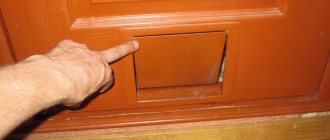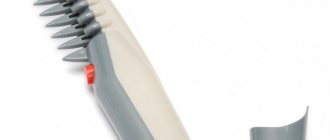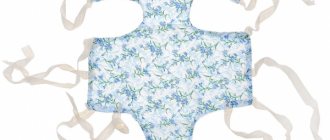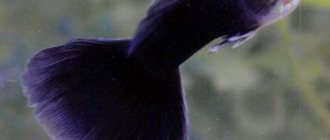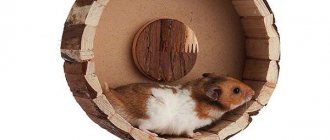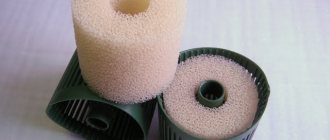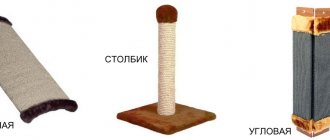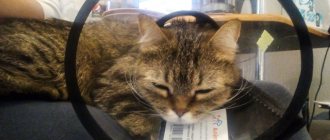All the ropes are numbered, so all you have to do is tie them correctly.
The action plan is:
- Place the cat directly above the bandage. Attach the ribbons numbered 1 to the neck. If the animal is sleeping, then lay it on its side, attach the product to the tummy and tie a bow on the neck;
- Make sure the foot notches are in the right place and secure ropes numbered 2 and 3 in pairs on each side;
- Fasten the bands at number 4 in the middle of the body;
- Tie ropes No. 5 into another bow in the lower back area;
- Connect in pairs ribbons number 6 and 7 on one side and numbers 6 and 7 on the other so that they wrap around the hips. Tie the resulting knittings together.
Please note that putting a blanket on a cat correctly is not at all easy. The medical apron should fit snugly to the stomach and chest, but not interfere with blood circulation. Do not tighten the tapes too much, as this will lead to chafing of the seam. It is enough if you can stick two fingers under the bandage.
The veterinarian determines how long to wear the blanket after surgery. In most cases, the rehabilitation period lasts 7-10 days. After removing the suture, leave it for 2-3 days, and then remove the bandage.
Precautionary rules
The blanket restricts movement, so the cat will feel uncomfortable at first. The owner's task is to distract the pet (pet it, give it a treat, etc.). After a day or two, the animal will adapt and stop paying attention to the protective device.
If the cat does not want to be distracted and strives to get rid of the blanket, using its teeth and claws, then you can:
- calm the animal down a little by giving a sedative (the drug is recommended by the veterinarian);
- restrict freedom of movement by placing it in a box (for example, for transportation);
- use an Elizabethan collar.
Make sure that the ropes are not too long, as the cat may get caught on the furniture when moving and damage the integrity of the seam. If necessary, trim the ends, carefully processing the edges afterwards.
There is no need to remove the bandage completely during medical procedures. To open access to the wound, simply untie a few tapes and pull back the material.
Medical bandage for pet
To close a wound on the body of a domestic cat, ordinary bandaging is not enough. Feeling pain, the animal pulls off the bandage and chews out the surgical threads, risking infection in the suture. Therefore, veterinarians advise putting a sterile blanket on your pet. It is a blanket with holes for the paws and is tied at the back with ribbons. The device covers the lower part of the cat's body from the neck to the tail.
The main property of the product is to prevent pathogenic microflora from entering the surgical incision . Additionally protects the surface of the wound from sunlight and mechanical damage. When treating a sore spot with medications, the coverlet is partially untied without completely removing it.
Other uses:
- protection of the animal in the treatment of purulent ulcers and eczema;
- fixation of drainage;
- ensuring safety during treatment with acaricides;
- isolation of the tumor in the chest area;
- preventing contamination of animal care items.
The cost of a regular sanitary dressing is quite affordable. In November 2022, it was 75–120 rubles. This is a simple model with ribbons. If desired, the owner can purchase another version of factory tailoring with a pattern and fasteners with buttons, but in this case the price of the product will be from 1,700 rubles. a piece.
Dress for the sphinx
Using a simple pattern, you can make a beautiful dress for your hairless Sphynx cat. The most remarkable thing is that a dress of this kind can be made from just two pieces. First of all, the main part is made, and then the sundress, which is sewn to the base.
For your information! All this takes very little time, but looks very attractive. Do-it-yourself clothes for the sphinx, the patterns of which are presented in the picture below, can be made in a matter of hours.
Knitted suit on a Canadian cat
What types of blankets are there for cats?
There are several types of protective clothing for pets. The products differ from each other in material and cut features. Each option has its own purpose.
Warm
During the cold season, hairless cat breeds get cold and run the risk of catching a cold. Caring owners of Sphynxes and Cornish Rex dogs dress their pets in warm sleeveless vests. Soft fabric with a small pile perfectly protects from the wind and warms the animal during a walk. Even better are knitted wool blankets that fit the body. This product replaces the mustachioed friend’s own fur.
For hairless cat breeds, a warm blanket is an indispensable wardrobe item.
Homemade
Among furry pets, there are also those who suffer from allergic shedding. The owners have to constantly vacuum the furniture and often comb out the animals, although this does not save the situation. But you shouldn’t envy owners of “hairless” cats. Unfortunately, they have another physiological feature - increased sweating. There are stains on sofas and armchairs that are difficult to remove. Therefore, pets are dressed in blankets made of light cotton fabric, reminiscent of a robe or T-shirt. Such clothing absorbs skin secretions well and limits hair loss.
A satin blanket will protect furniture from your pet's sweating
Most home capes still belong to wardrobe items. However, some models are necessary for the daily care of animals with incurable diseases.
When veterinarians discovered a tumor on an elderly cat's mammary gland, the owners were forced to make difficult choices. They did not agree to the operation, which still would not bring recovery. The pet constantly reached out to the sore spot and licked it. Redness and inflammation began. Then the owners put a loose blanket on the cat. It is surprising that the animal quickly got used to the “cover” and only slightly protested at first. The tumor, covered with tissue, became less inflamed by the actions of the furry pet. The use of a protective device thus made it possible to extend the earthly existence of a doomed living creature for another year and a half.
Fastening a blanket with a zipper is much more convenient than tying ribbons
Raincoats
When walking with your pet outside in cloudy weather, do not forget to take a rain cape for your pet. The model has a hood and fastens under the neck and belly. The product is sewn from waterproof material - nylon or vinyl chloride. Polyamide fiber of bright color is not inferior in properties to transparent film. In the event of an unexpected downpour, only the animal's paws will get wet in such a raincoat.
Postoperative blankets
It's hard to say when veterinarians came up with the idea of covering surgical stitches on pets with a large bandage that attaches to the back. Since the sixties of the last century, only an Elizabethan collar was used to isolate the wound from the animal’s reach. The cone attached to the cat's neck caused significant inconvenience. Not only could the pupil not wash her face, she found it difficult to drink and eat. The owner watched with pity as the funnel knocked on the cup of food, but the food did not fall into the mouth. We had to temporarily remove the device and risk the health of our mustachioed pet. Moving around the rooms threatened with injury: the edges of the cone clung to furniture and door frames.
It is not surprising that the blanket has become an excellent replacement for a neck device after abdominal surgery. It's nice to see that your pet feels freer and can even play. Although the protective mantle with ribbons still restricts movement, it does not prevent the cat from eating and caring for itself normally. Therefore, the animal’s recovery occurs faster.
And now in some European countries veterinarians only use a collar. As an alternative, they recommend that owners put homemade sleeveless vests on their animals, made from baby overalls for infants.
Interestingly, in Russia, Sergei and Angelina Kovalev received a patent for the invention of a postoperative blanket for domestic cats in 2002. Their product is conveniently fastened with Velcro located above the neck and spine of the animal.
Briefly about the purpose
We will not consider the options for the mentioned “clothing” only as an interesting addition to the image of a pet, although in some cases a blanket is really needed for practical purposes (for example, for heating short-haired or hairless cats and cats).
Most often, this element of a cat's wardrobe is used to protect the postoperative suture from dirt, pathogens, fungi, and even the tongue of the animal itself, which strives to lick the wound. Inflammation of the suture is one of the most important complications after surgery, so it’s not worth the risk.
Created on a fabric basis and placed on the cat immediately after the procedure, the bandage will block any access to the stitches and facilitate their quick tightening. In many private clinics, it is given to each operated animal at no additional cost, but even if this does not happen, you can purchase a blanket at any specialized store with a large assortment of similar products, or, as a last resort, sew it yourself.
Important! Before looking for a post-operative bandage or making one yourself, check with your veterinarian whether it is necessary to use it, because today there are many suturing technologies, after which a blanket is not required or may even cause harm. There are several types of blankets depending on their purpose - postoperative and protective (warm and waterproof)
There are several types of blankets depending on their purpose - postoperative and protective (warm and waterproof).
In the postoperative period, it is necessary to protect the sutures from licking - cats tend to lick their wounds and chew out surgical threads, which significantly complicates and prolongs the healing period. In addition, the intervention area should not be exposed to dirt and dust, and given that animals actively move around the house and are in the darkest corners, this can be difficult. A special postoperative blanket solves the described problems. It is worth acquiring if the following interventions have been carried out:
- castration of a cat (removal of the ovaries or ovaries along with the uterus in order to prevent further reproduction);
- surgery on the organs of the digestive system (stomach, intestines, etc.);
- surgeries on the urinary system (kidneys, bladder, etc.).
A postoperative blanket for a cat allows you to protect the wound after abdominal surgery from licking and dirt.
Choosing a sanitary dressing
You need to take care of protective equipment for your pet in advance, even before the scheduled operation. Then your pet will quickly get used to the medical gown, and wearing it after sterilization will not aggravate the stressful condition. Prepare at least two hygiene items to replace it after it gets dirty. When purchasing a product, pay attention to its appearance and fabric composition.
Material
Medical blankets in pharmacies at veterinary hospitals are usually made of non-woven fabric. This base does not contain lint and does not crumble if you need to trim the product to make it more comfortable for the animal. The pressed fibers perfectly absorb liquid, keeping the surface of the wound dry. Another advantage of such a base is its resistance to tearing by claws, as well as a long service life. The product can withstand repeated washing and does not affect your pet's skin.
Factory blankets are sewn from different fabrics:
- cotton;
- viscose;
- spunbond;
- meltblown.
To ensure free access of air to the wound, material made from natural threads is preferable. Foreign manufacturers often use a cotton-lycra blend to give the product stretch. In this case, the fabric limits freedom of movement less.
Size
Before purchasing a product, you need to weigh the animal, and also determine the circumference of the chest (behind the front legs). The length of a large bandage will be 7 cm longer. If the bandage is chosen correctly, then the width of the open part of the pet’s back is no more than 8–9 cm . The volume of the product is easy to adjust with ties, but the size remains unchanged.
Factories usually sew post-operative blankets for adult cats weighing 3–5 kg. Finding a protective device for a kitten is more difficult. For him, the size of the product along the length of the body from the base of the neck to the beginning of the tail will be 28 cm, and the model range starts from 38 cm with a chest circumference of 31 cm. Large animals with a body weight of 6–10 kg will be suitable for a protective bandage with dimensions of 42x35 cm.
Model type
There are several types of medical blankets for cats. They differ in the processing of the holes for the paws and the way the bandage is secured to the animal. A one-piece product with slits is less common than a coverlet that covers the limbs. The sleeveless robe is trimmed with a durable piping that covers all the edges and prevents the fabric from fraying.
A blanket with cutouts for cat paws is used in the treatment of back wounds
Most post-surgical blankets are secured to the pet's back with 6-7 pairs of ribbons. Bandages with Velcro fastening are much easier to use . The wide apron can be easily removed if necessary. On an individual order, the tailor can improve the fastening by replacing part of the ties with a zipper braid.
There are also expensive models with push-button clasps on sale. They are located on both sides near the animal's neck. Dutch manufacturers have equipped the hygiene product with an internal pocket. A bandage with medicine is placed there.
Caring for the bandage
The bandage needs to be changed when it gets dirty or wet (for example, after going to the toilet). It is recommended to treat a fresh (washed) product on the inside with a steam generator.
You need to have two or even three blankets available in order to promptly replace a dirty bandage. If it gets wet or gets infected, the seam may become inflamed!
The blanket protects the postoperative suture from dust, dirt, bacteria and prevents inflammation, thereby reducing the duration of the rehabilitation period by several times. But you need to choose a quality product, since otherwise wearing the device can even cause harm.
How to make a blanket with your own hands
If you decide to sew a post-operative bandage for an adult cat yourself, then it is better to use your own knitted items for this. The animal knows the smell of the owner and wearing such a product will cause less protest than with a factory bandage. The summer dress your daughter has outgrown is also suitable for sewing a large headband.
Tools and materials
To make a protective blanket, use chintz or printed calico, which are sufficiently breathable and at the same time soft and dense. It is advisable that the new fabric be washed in advance, otherwise it will shrink during use. The blanket is sewn from two layers of light-colored material.
We will need:
- pins;
- pencil;
- ruler;
- scissors;
- threads;
- needle;
- textile;
- tapes.
To take measurements from your furry pet, use a tailor's centimeter. It is also suitable for marking blankets if the length of the ruler is shorter than 40 cm.
Manufacturing stages
Lay out all the parts to work on the table. The model will have 14 ribbons, so you will have to use 3.5 meters of ribbon. It can be replaced with strips of any durable textile or synthetic material.
Cutting the required amount of fabric
Together with an assistant, measure the cat and write down the obtained values. Usually the animal takes your actions as the start of the game, so it will be difficult to cope alone.
Main parameters:
- body length from the neck to the beginning of the tail;
- chest girth;
- abdominal circumference;
- distance between all four paws.
The piece of fabric for cutting has the shape of a rectangle. The dimensions of one piece are 38x32 cm with an allowance of 0.5 cm.
Manufacturing process:
- The fabric is folded in half with the wrong side out.
- Fasten with pins so that it does not move.
- From the top edge of the front part, put 5 cm to the fold, mark with a pencil. There remains 10.5 cm to cover the animal's neck.
- Draw cutouts for the front paws 12 cm deep and 6 cm wide. Their shape resembles an oval.
- The length of the fixing bandage over the cat's spine is approximately 16 cm. The size under the belly is 38 cm. At the tail between the hind legs, half the width along the edge will be 4.5 cm. The value is measured from the fold upward, a notch is placed, then 10 cm is set aside along the outer edge of the fabric.
- The resulting angle is rounded inside with a pencil.
- Place marks on all places where the tapes are attached.
- Using scissors, cut out the contours of the product.
- Take out the pins.
- You get two blanks for a postoperative blanket.
Sewing on ribbons to secure the bandage on the pet
Each 25 cm long ribbon is stitched from one edge so that the threads do not spill out. Then all 14 pieces are placed with the other end on the wrong side of one part of the blanket, sewn by hand or using a machine zigzag stitch. Check that the ties are held tightly. They try on and remove excess tissue if necessary.
Edge processing
To ensure that the device is of good quality and safe for caring for your pet, all open areas of the material are carefully closed and stitched. If even one small thread gets into the wound, it will immediately begin to rot. Inflammation of the surgical suture is the most common postoperative complication . This is why quality processing of tissue sections is so important.
There are several ways to insulate the edge of a product. The simplest one: on both parts of the blanket, fold the edges inward and sew by hand along the right side of the fabric. Make two parallel lines at a distance of 3 mm from one another. You can cover the sections with edging made of fabric in a contrasting color. The third option is the most time-consuming. Place the two parts of the blanket together, face inward, and pin the attached ties to the center of the product. Stitch both pieces together, leaving no seams for the ribbons. Turn it inside out, remove the pins, and pull the ribbons up with the free ends. After this, sew the outer stitch. This results in a strong connection with closed edges.
Instructions for putting on
Most often, the blanket is secured to the animal’s body using regular ties. Velcro versions are available for sale. Dressing a cat in such a bandage is much easier, but blankets with Velcro are more expensive.
The first putting on of the blanket occurs immediately after the operation. Most often at this time the animal is still under anesthesia or only partially conscious. In this state, the cat does not offer resistance, which greatly simplifies the process. You should be very careful and careful, do not make sudden movements when manipulating the animal’s body: fresh seams can be damaged very easily.
In the future, you will have to repeatedly treat the wounds and put a bandage on an already active animal.
It is important to act as calmly as possible. If a cat is nervous and resists, talk kindly to your pet and pet him
Spread the bandage on the table and place the cat on top of it, tummy down.
It will be better if someone helps you the first time - it is much easier to carry out this process together.
Using the fixture
The doctor puts a bandage on the cat immediately after sterilization, while the animal is under anesthesia. Before tying a protective blanket, press a sterile napkin soaked in an antiseptic to the wound. The blanket not only covers the damaged area of the skin, but also limits the animal’s movements. This is necessary so that the active scratch does not jump, otherwise the seams will come apart. The surgical incision is inspected and processed every other day, untying some of the tapes on the back and at the hind leg. If liquid appears on the surface of the fabric, the bandage is changed immediately.
After the surgeon removes the suture threads, the blanket is put back on the pet to protect the surface of the wound. But now the sanitary bandage is worn for 3–5 days. If the healing of the skin area is complete, the safety gown is finally removed.
How to fix it correctly
A blanket is laid out on the table and a cat is placed on top. If your mustachioed beast is impatient, ask another person to gently hold her. Talk kindly and calm the animal. Ribbons of the first pair (at the neck) are tied together above the withers, and numbers 2 and 3 are crossed above the beginning of the back and secured in one knot. The ribbons at the hind legs are connected on opposite sides: the sixth on the right and the seventh on the left. Tied together. The remaining two pairs of ribbons (4 and 5) are tied on the cat’s back. Veterinarians recommend making the ends of 7, 6 and 5 rows of ribbons in one knot to reduce the inconvenience of wearing a blanket for the animal.
The blanket should not be tied too tightly to prevent swelling of the pet’s skin.
The bandage should not be tight or too loose. It is considered optimal if a finger fits freely under the bandage. When an animal cannot walk in a blanket and falls, the fastening above the ridge is too rigid and should be loosened. Make sure that the cat does not accidentally damage the ribbons.
How long can you wear it without taking it off?
If the wound is dry, there is no swelling or redness, then after 8–10 days the bandage is removed. But at the same time, the cat cannot be left alone. Watch how she behaves. If he begins to intensively lick the wound or injure the sore area, then he will have to put on the blanket again and show the animal to the doctor. The cause of restless behavior is probably hidden inflammation.
Video: a cat walks around the house with a large bandage tied on its back
Features of using the bandage
For a cat, an oval cutout is made on the belly under the tail using a purchased or homemade blanket. Otherwise, you will have to untie some of the ribbons from the back and turn back the edge so that the animal can go to the toilet. This is inconvenient for both the owner and the sick pet.
Our mustachioed friends have different views on being forced to wear a blanket. Some show hatred with their entire appearance and persistently try to remove it by biting the ribbons with their teeth. Others are cunning and pretend that the protective bandage does not bother them at all. The reason for this behavior is simple - the cat is patiently waiting for the ribbons on its neck to loosen. And one morning you find your pet without a bandage, which was left lying somewhere in the corner of the room. It turns out that the cat has already pulled out all the threads from the wound. It is good if the suture is almost healed, i.e. there is no bleeding or fluid discharge. In some cases, you have to take your unruly pet to the surgeon again. Then the treatment is delayed for months, and a scar remains at the site of the incision.
Purpose of the product
A blanket is placed over your pet's belly to protect the belly after surgery. Thanks to this cover, the surgical site is not affected by pathogenic microflora, and the animal will not be able to scratch and lick the wound. So the cat reflexively tries to speed up the healing process, but in reality this only leads to irritation. Along with her saliva, germs and viruses can enter the wound.
The product is tied tightly. It pulls the edges of the wound together, making regeneration faster. The body will have to spend less energy on tissue restoration.
A correctly applied blanket prevents the abdominal muscles from weakening and stretching . Therefore, a sterilized cat’s belly will not sag.
Medicines: analgesics, suture antiseptics, antibiotics, vitamins
Analgesics will need to be given for the first 2 days. The fact that the postoperative wound hurts is indicated by a change in the animal’s behavior. The cat shows aggression, meows, and refuses to move.
Analgesics will be required for the first 2 days.
Doctors recommend using painkillers:
- Ketoprofen (1% solution). The injection is given subcutaneously or intramuscularly once a day. The dose is calculated at 0.2 ml per kg of weight. Inject no more than 4 times.
- Tolfedine (tablets). Given with food. Dosage: 4 mg per kg.
- Meloxicam (suspension). On the first day, give 0.1 mg/kg, and in subsequent days, reduce the dose by half and give 0.05 mg/kg.
To treat sutures, veterinarians advise using:
- chlorhexidine 0.05%;
- Dioxidin 0.5%;
- Chemi spray;
- Vetericin spray.
During the recovery period after sterilization, antibacterial drugs are not prescribed. Antibiotics may be required if postoperative complications occur and an inflammatory process is detected.
For treatment use:
- Amoxicillin 15%. 1 ml/kg once a day for 5 days subcutaneously or intramuscularly.
- Sinulox. 0.5 ml/kg intramuscularly for 3-5 days.
Vitamins and restoratives are given only to old or weakened individuals. Gamavit is prescribed at 0.05 ml/kg for the first 3 days, and then the dose is increased to 0.1 mg/kg and given for 2 weeks.
How much material is needed
A cat is a small animal and at home you will always find the necessary piece of material to prepare a bandage. You can use your old things and give them new life. You need to sew 2 - 3 bandages at once.
The first blanket for a cat after sterilization will almost certainly become stained with blood, and it will need to be changed.
Each bandage should consist of three layers of fabric.
- The top one should be strong enough so that the cat does not tear it apart in the shortest possible time. The second requirement is that it should not allow moisture to pass through. The cat's body should remain dry under the blanket. And, of course, every housewife will want a beautiful thing.
- The purpose of the middle layer is to warm the stomach. Therefore, the fabric is chosen so that it protects well from the cold and is soft at the same time.
- The flexibility of pussies is well known to everyone, but thick, hard tissue will not allow them to behave naturally.
- Finally, the layer adjacent to the belly should be made of a delicate and soft material. Flannel or knitwear works great. Especially from worn items that have been washed several times.
How many layers of material are needed?
It is best to sew a bandage yourself using three layers of fabric:
- the top one should be decorative or waterproof;
- the middle one needs to be made of warm or soft fabrics, it will have a warming function;
- the inner layer will adhere to the cat's body. It is best made using flannel or knitwear.
The best option for a blanket after sterilization for a cat is two or three layers, stitched edges and tie strips. To make the bandage as durable as possible, it is better to sew it yourself using cotton.
The ties need to be made longer, and when you try the blanket on the cat, remove the excess from them. This is necessary so that the animal does not get entangled in them. Determine the location of the cat's paws immediately so as not to disturb her with fitting. If after sterilization there are wounds on the animal’s body, then a bandage based on several layers should be placed under the blanket.
What to replace it with?
If a person is not good at sewing, then for such work he will need children's clothing in the form of a bodysuit. You can make a blanket from scrap materials. If the animal is small, a belt made from a sock will do.
It is important to remember that the sock must be completely new and never used. Slots are made in the designated places through which the paw can be inserted
However, such a blanket is unreliable because it can be easily removed. For an adult cat, a blanket made from tights is suitable. It is important that the product has increased density. In addition to tights, you can use a pant leg or sleeve cut off from unnecessary clothing. As in the version with a sock, holes for the limbs are cut in the required places. A good option that replaces the cat wrap is a baby bodysuit.
Warm
Cats, which are representatives of hairless breeds, often freeze when there are cold seasons outside the window. This not only causes significant discomfort for pets, but can also lead to the development of colds. In such circumstances, a special warm blanket would be an excellent solution.
Most often, caring owners of Sphynxes and Cornish Rexes turn to such things. These types of blankets look like simple sleeveless vests.
The best and most comfortable blankets are warm blankets made from soft fabric with large pile. Such things effectively protect hairless or short-haired cats from low temperatures and cold gusts of wind. Even during a walk, your pet will be warm and comfortable in a cozy blanket.
Separately, it is worth highlighting the knitted woolen blankets that fit the body well. These specimens are especially warm and have an excellent warming effect. They are very comfortable for cats and kittens.
A knitted wool blanket can easily be an excellent replacement for cat fur.
How many days to wear
If you put on the blanket correctly, the animal will quickly get used to the new item of clothing. But it happens that the cat is constantly unhappy and tries to remove it. And then the owners are tempted to remove this bandage that limits mobility. Don't let the animal pressure you into pity.
It is very important to wear the blanket for as long as necessary for healing. Only a veterinarian can determine exactly when the protection can be removed, but this is usually done two to three days after the external sutures are removed.
Sewing features
This device is a rectangle of thick fabric with cutouts for paws and ties on the back. You can make the pattern yourself on a piece of newspaper (leaving some extra for seam allowance).
Pattern for a medium sized cat.
The blanket is secured using ties or Velcro. You should not make buttons or buttons. In this way, reliable fixation is ensured, and the cat will not be able to pull off the bandage on its own.
When sewing, the following dimensions are taken into account:
- Body length from neck to tail.
- Distance on the stomach from the front to the hind legs.
- Chest volume.
- Abdominal volume.
- Circumference of the tail and each paw.
Expert opinion
Burmistrova Alena Valerievna
Breeder, 7 years experience.
The ties will be located on the back, their size must be adjusted, the long ends should be trimmed if necessary. To prevent the animal from accidentally getting caught and injured, the material of the ties should not withstand the weight of the animal or strong pressure.
It is better to sew on new ropes than to expose your pet to the risk of suffocation. Despite the fact that in the first days after surgery, the animal needs round-the-clock monitoring, unforeseen situations cannot be discounted.
